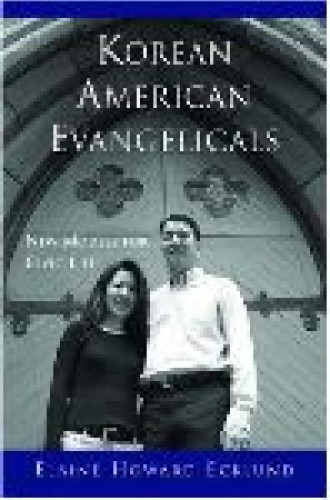Second generation
Among all the newer arrivals on the American religious scene, Korean immigrants are the champion church builders. A century after the first Koreans arrived in the newly annexed territory of Hawaii, their followers and descendants had established 3,000 congregations across the 50 states—one for about every 350 members of their community. (That figure compares with one congregation for every 850 persons in the population at large, a ratio that itself reflects a heavily churched society.)
Overwhelmingly Christian, for the most part evangelically inclined Protestants, Korean immigrants are avid churchgoers. Predominantly highly educated with middle-class occupations, they have the material and intellectual resources to found and support their own institutions.
But what about their children? Twenty years ago, Korean American church leaders began to worry about a “silent exodus” of the second generation, who seemed to be disappearing out the back door of their parents’ churches on their way to college. Many worried that their children were abandoning the faith. Those who listened to the youth heard their particular concerns, which they quietly expressed so as not to dishonor their elders.
Members of the second generation were not fluent in the parents’ native tongue, but at their parents’ churches the pastors typically spoke English with a thick accent and without awareness of American idioms (if they spoke English it at all). The second generation was raised in a country whose pervasive popular music idolized guitars and drums and whose culture elevated spiritual authenticity over institutional fidelity, but their fathers got into somber suits to go to church and took election to church office extremely seriously. Younger Korean Christians complained that their parents were more concerned that they honor Korean culture and get good grades than that they follow the Christian faith.
Eventually, in college and afterward, masses of Korean American youth enthusiastically embraced Christian faith—but on their own terms. They did so by developing a distinctive style of praise music and organizing de facto congregations, called English-language worship services. Today, when Korean American Christian fellowship groups are highly visible on elite college campuses and congregations of English-speaking Korean American young adults abound, there is less talk of an exodus. Now the question, capably addressed by Elaine Howard Ecklund and Rebecca Y. Kim, is not whether but how second-generation Korean Americans (SGKAs, in Kim’s formulation) will express their Christian commitment. (These books are revised sociology dissertations, and it is necessary for me to record that I am thanked by both authors.)
Kim looks at SGKAs who are students at one highly selective public university and asks why, given their proficiency in English, impressive educational credentials earned in interracial high schools, and rosy occupational prospects—the attributes that make them “whiz kids” or a “model minority” in the eyes of some—they so often prefer to worship with their own kind. They choose what Kim dubs the “Korean American Mission for Christ” over the available multiracial campus fellowships.
Given the critical mass of Asian Americans on this particular campus (where they make up 40 percent of the student body), they can easily segregate themselves, and a cynic might observe that they are simply acting like other Americans, the great majority of whom worship in effectively segregated churches. But neither Kim nor the more reflective of her subjects are content with such an answer, which defies the universalistic creed they embrace and the evangelistic goals that they somewhat abashedly profess. Kim is also not satisfied with the answer they do tend to give: that it’s more “comfortable” for them that way.
The common cultural experience of SGKAs binds them together and divides them from other Christian students (especially the whites whose socioeconomic privileges they tend to share but whose different backgrounds SGKAs tire of having to take into account). “With each other, SGKAs can complain about their Korean parents, crack jokes using certain Korean terms, and swap stories about what it was like growing up in Korean churches.”
Other elaborations on comfort point more clearly to racial experiences that SGKAs would just as soon not recount, ranging from crude taunts (“Why are your eyes so small?”) to stereotyped expectations (that they are “all kung fu masters”) based simply on perceived physical difference.
Writing with wisdom and authority that must stem from her personal experience as a self-described 1.5-generation Korean American as well as from her assiduous studies, Kim recognizes that the comfort account has both ethnic and racial aspects and that the religious segregation it produces goes two ways. It is both voluntary and imposed. It is pervasive, but it generates an uneasy conscience. It is persistent, but it can take forms that do not preclude interethnic cooperation. Packed with information on historical context and deeply informed by a growing literature, God’s New Whiz Kids? is both first-rate sociology and essential reading for church leaders who want to ready themselves for an ethnically and racially complex future.
Ecklund’s study takes up where Kim’s leaves off—with the church lives of SGKAs after they finish college and have embarked on careers and the formation of families. Intensely aware of, but disturbed by, the pattern of self-segregation among young Korean American evangelicals, Ecklund is less interested in understanding the roots of their religious behavior than in analyzing its consequences for American civic life. Ecklund wanted to find out what notion of citizenship is fostered in these churches. Her hope is that Korean American evangelicals might push American evangelicalism in a progressive, social justice–oriented direction
To ferret out what the ethnic church means for civic life, Ecklund knew that she needed a point of comparison. So she conducted her research at two sites, one of them a more or less typical second-generation congregation (which she calls “Grace”) that meets in the same building as its parent Korean immigrant congregation, and the other (“Manna”) a predominantly Asian American but remarkably multiethnic congregation that meets in a building owned by an African-American congregation. All but three of the regulars at Grace (Ecklund was one of only two whites) were Korean, whereas Manna had Chinese and Korean leaders and numerous white, black and Latino members scattered among its Asian majority. To make sure that she wasn’t looking just at two outlier cases, Ecklund conducted additional telephone interviews with other Korean Americans across the country, equally divided between those who attend monoethnic churches and those who attend multiethnic churches.
Ecklund is convinced that monoethnic churches are civically unhealthy. The strongest evidence on that point appears on the first page of her book, where “Bill,” a member of Grace, talks about his identity as a Christian and an American and about his volunteer work, through the church, at a local shelter for disadvantaged teens. He confesses that he cannot relate well to many of those his group serves at the shelter because they are poor blacks. Ecklund sees this limitation on Bill’s part as due to the way Grace reinforces his Korean American identity without bringing it to consciousness. The homogeneous experience at Grace normalizes Bill’s identity so that he can think of himself as a plain “American” and “Christian” in contrast to others who are implicitly lesser. How much better to be a member of a church that, following a different “model of civic life,” has to confront its internal diversity. In People of the Dream, reviewed in these pages last year, Michael Emerson, one of Ecklund’s mentors, extols multiracial churches for this reason.
At this point Ecklund’s account gets murky. She thinks that for Korean Americans to be the progressive force in evangelicalism that they have the potential to be, they must not simply step outside their comfort zone into heterogeneous churches but must identify (and worship) with other nonwhites, especially with African Americans. For many reasons, this is a difficult recommendation.
First, it is highly unrealistic. Although Manna appears to be majority nonwhite, we do not know the ethnic mix of the churches of the half of her subjects that she interviewed by phone. Were they pan-Asian churches? A mix of whites and Asians? Asian-white-Hispanic mixtures? From what we know about race and religion in America, it is exceedingly unlikely that the churches had a substantial number of African-American members.
Second, the category “nonwhite” presupposes that Korean Americans will, into the indefinite future, be categorized alongside African Americans as nonwhites. This assumption ignores the possibility that a “beige America” is emerging from the high rates of Asian-white intermarriage and the self-classification of many Hispanics as “white.”
Third, Ecklund’s vision of nonwhite solidarity has no place for progressive whites (like herself). It’s possible that an increasing white presence in Asian churches (and vice versa) might have some leavening effect on both Asians’ and whites’ empathetic capacities. By insisting that the rigid color line that has historically poisoned relations between European Americans and African Americans will do the same with respect to Asians and whites, Ecklund forecloses too many alternative futures.
Still, Ecklund raises many of the right questions that are left to be explored at the end of Kim’s less ambitious study. She quotes extensively from interviews, allowing the reader to hear the diverse voices of SGKAs on what being Korean, Christian and “good Americans” means even when what they say does not neatly fit her theories. She makes two helpful distinctions in her discussion of models for civic life. One is between the kind of Grace-sponsored service activity that does nothing to open the social world of people like Bill, on the one hand, and the pattern typical of Manna, on the other, where members individually choose volunteer activities that do not put them, as members of one solidary group, in the position of being benefactors to another group with whom they have no other contact. Her other distinction is between such volunteer civic activities, which many SGKAs willingly participate in, and the political activities that most still shun.
Above all, Ecklund does not patronize her subjects by asking only under what circumstances the dominant society will accept them. Instead she engages them in the question of how they can change the society for the better.






